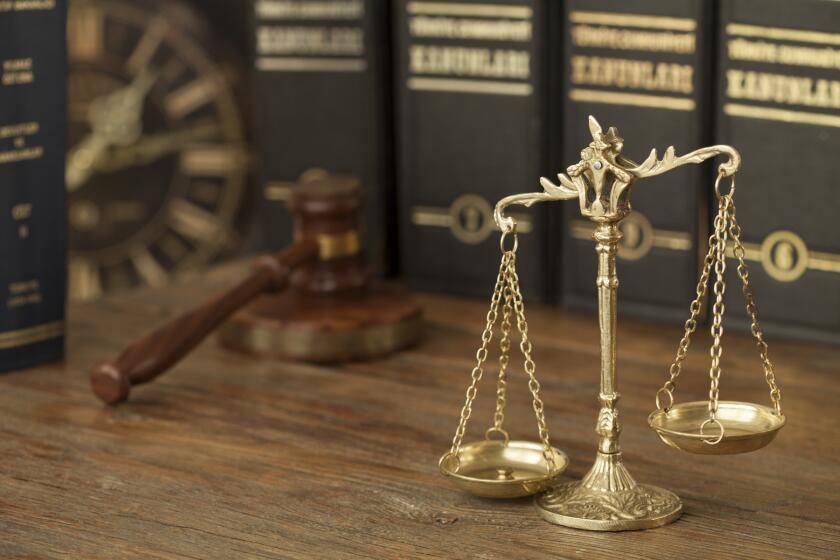NATURAL PERSPECTIVES:
- Share via
Some days are just packed with fun things, and some weeks are packed with fun days. Vic and I started our week by going to the Los Angeles Museum of Natural History with our granddaughters from San Diego.
The twins, Allison and Lauren, are nearly 3 and working on their language skills. They love naming things, especially birds and animals, so a visit to a museum or zoo is a perfect opportunity for them to practice their skills. We try to let them enjoy things in their own way, which at this age involves running and touching.
In the Hall of North American mammals, they ran from case to case, pointing out and naming the animals in each diorama. In the bird exhibit, they pulled out drawers to look inside, pushed buttons to light up displays, and identified flamingos, penguins, ducks, geese, condors and owls, much to Vic’s delight.
After lunch, we went to the Discovery Center at the museum, where kids can touch everything. The girls absolutely loved that. Their favorite thing was a low table with huge shells, coral and rubber lobsters on it. They kept picking up one thing after another to have it named for them. They enjoyed the mounted polar bear that stands 8 feet tall with enormous paws and ferocious-looking glass eyes. They crawled around, on and in various things designed for that purpose.
The best part by far was the up-close-and-personal dinosaur encounter. After all the kids were seated in the darkened Hall of North American mammals, a 9-foot-tall juvenile Tyrannosaurus rex puppet (think Big Bird) came running into the room.
There was a skilled puppeteer inside the costume working the head and tail, but we quickly forgot the puppet part. This dinosaur looked and acted real, with incredible movement, amazing behaviors and even roars and other dinosaur sounds. Vic and I were both impressed by the lifelike movements of this gigantic puppet, and by the combination of humor and information from the master of ceremonies. This T. rex also exhibited all the latest research on dinosaurs, being fully feathered with big lizard scales on the head.
T. rex dashed out at a jerky lope, and went right up to the kids sitting on the floor in the audience.
A few of the kids screamed but quickly settled down when the dinosaur didn’t eat them. T. rex acted like the wild animal that it was, needing to be herded by two “handlers.” I was concerned the twins would be frightened, but they apparently felt safe on their parents’ laps at the back of the audience.
The twins had big, amazed smiles on their faces right up until the end of the performance. When T. rex left, it stalked past the twins, stopping to breathe directly in their faces. The dinosaur’s head was as big as each little girl. They trembled in fear at that point but didn’t cry. Later they said the best part of the museum was the “silly dinosaur.” Even adults will enjoy this amazing performance. Don’t miss it.
That would have been enough excitement for most weeks, but it was just the start of this one. My next activity was making Native American story sticks with the Friends of Shipley Nature Center docents. A story stick is a walking stick that is decorated with fur, feathers, bones and shells, and is used to remind the storyteller of various things to talk about. I had visited Matoska, a store in Orange, with the docents earlier to buy leather thongs, rabbit fur, raccoon and coyote tails, feathers, reproduction grizzly claws, coyote teeth, obsidian arrowheads and other objects for our sticks.
I presented a workshop to the docents on the lifestyles of local Tongva and Acjachemem people at the time of the arrival of the Spanish padres in the late 1700s. Actually, much of that material is contained in the permanent displays at Shipley Nature Center, which I wrote.
First, I did a sage smoke blessing, and then talked about the transportation, housing, food, clothing and tools that were used by the local tribes, as well as social customs. Then we assembled our story sticks, using the leather thongs to tie objects to the sticks. I used an electric drill to make holes in the shells and deer toes. Local Native Americans also had drills, but they were hand-powered with a bow and string, using a chipped obsidian drill bit at the end of a short stick. They used these drills to make holes in shells for jewelry. Shells were also strung on a piece of string made from yucca fibers and used as money in trade.
My week started and ended with the granddaughters. After the Shipley workshop, Nicole and I took the three girls — Allison, Lauren and baby Megan — to Julian to pick apples at Raven Hill orchard next to Menghini Winery. After we had picked two bags of apples, I cut up an Empire apple and fed it to the twins, which they greatly enjoyed. The sweetness and juiciness of a freshly picked apple is beyond compare.
For lunch, we went to the Julian Café and Bakery, which is decorated with Native American and cowboy artifacts. The twins were transfixed by all the objects on the walls, especially the huge horns of a bull. I took them on a tour of the restaurant’s decor, talking about how holsters, horseshoes and stirrups were used.
The world is filled with educational opportunities. Look for them, enjoy them and pass on the culture. Grandparents are nature’s teachers.
VIC LEIPZIG and LOU MURRAY are Huntington Beach residents and environmentalists. They can be reached at [email protected].
All the latest on Orange County from Orange County.
Get our free TimesOC newsletter.
You may occasionally receive promotional content from the Daily Pilot.



